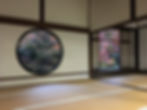What Japanese Gardens Teach Us About Depth—And Life
- Joshua "Gensetsu" Smith, PhD
- Jan 2
- 4 min read
Updated: Apr 22
Japanese gardens are more than just beautifully arranged plants, stones, and water features. They’re spaces that invite you to pause, reflect, and discover hidden layers of meaning. Beneath their apparent simplicity lies an intentional design aimed at manipulating depth—a principle not just for creating visual space but for inspiring emotional and mental expansiveness.
A recent paper, “Depth Perception and Visual Manipulation of Japanese Gardens,” explores how garden designers create these layered experiences. It’s not about adding more elements but using what’s there with an almost surgical precision to create a sense of vastness, tranquility, and harmony. Here are some fascinating insights from the study and how they can inspire our creative work and daily lives.
1. Layered Views: The Illusion of Infinite Space
One of the key techniques used in Japanese gardens is layering. Designers place objects—stones, trees, and water features—in a way that leads the eye from one element to the next. The layers gradually unfold, creating a sense of depth that makes the garden feel much larger than it is.
As the paper explains: “The arrangement of vertical and horizontal planes is carefully constructed to reveal sequential layers, which the observer perceives as extending far beyond the physical limits of the space.” This concept, known as borrowed scenery (shakkei), even incorporates elements outside the garden, such as distant mountains or trees.

Takeaway: In life, depth is often created by layers. Whether it’s the relationships we nurture, the stories we tell, or the work we produce, adding meaningful layers can expand how something is experienced without needing more physical space.
2. Framing: A Living Picture
Japanese gardens frequently use natural frames—openings between trees, windows in teahouses, or carefully placed gates—to guide your gaze. These frames turn the landscape into a living painting, drawing your attention to specific elements while leaving the rest in mystery.
The study notes: “Framing serves as a visual invitation, slowing the observer’s pace and focusing their attention on the transient beauty of the moment.” By focusing the viewer’s attention, the garden becomes an experience of presence and mindfulness.

Takeaway: Framing isn’t just for gardens or photographs. In our work and lives, we can use framing to bring focus to what matters most, creating moments of clarity amidst complexity.
3. Texture and Contrast: The Dance of Opposites
Another key design element is the interplay of textures. Smooth surfaces of water contrast with the roughness of stones and the softness of moss. This juxtaposition keeps the eye engaged, allowing you to experience the garden in a dynamic way.
The paper emphasizes: “Contrasting textures highlight the individuality of each element while contributing to the unified whole. This balance between opposition and harmony is a cornerstone of Japanese aesthetics.”
Takeaway: In both creative work and relationships, contrast adds richness. Opposites don’t have to clash—they can complement and enhance each other.
4. Perspective: Designing Beyond Limits
One of the most ingenious aspects of Japanese garden design is how it manipulates perspective. Elements like larger rocks are placed in the foreground, while smaller elements are positioned further away. This creates an illusion of depth and makes the garden feel expansive.
According to the research: “The calculated placement of elements enhances the observer’s perception of space, offering a sense of boundlessness even in confined areas.”

Takeaway: Perspective is everything. Whether it’s the way we approach challenges, design projects, or engage with others, a shift in perspective can dramatically change how we experience something.
5. Impermanence and Depth: A Wabi-Sabi Lens
Japanese gardens embrace impermanence, which deepens their emotional resonance. Leaves will fall, water will evaporate, and moss will grow. These changes are not flaws—they are what make the garden alive and dynamic.
The paper concludes: “By incorporating the principles of impermanence and natural cycles, Japanese gardens evoke a sense of profound connection to time and transience.” This ties directly to the philosophy of wabi-sabi, which finds beauty in imperfection and the ephemeral.
Takeaway: Depth isn’t static; it’s something that grows and evolves over time. By embracing change, we allow our work, relationships, and lives to deepen in ways we may not have anticipated.
Applying These Lessons to Everyday Life
What can we learn from the way Japanese gardens manipulate depth? Here are a few ideas:
In Your Work: Add layers to your projects—not by overwhelming with detail, but by thoughtfully incorporating elements that invite exploration. Whether you’re a designer, writer, or photographer, think about how you can guide your audience through an experience.
In Your Space: Look around your home or workspace. Could you use natural framing or contrast to create a sense of calm and focus? Even a simple adjustment—like placing a favorite object in a thoughtful spot—can shift the energy of a room.
In Your Perspective: When faced with challenges, consider how changing your perspective might reveal new possibilities. Sometimes, what seems confined is only an invitation to look deeper.
Japanese gardens are masterpieces of intentional design, showing us that depth isn’t about quantity but quality. It’s about creating space to pause, reflect, and see beyond the surface. As I continue to explore these principles in my photography and upcoming book, The Quiet Lens, I’m reminded that these lessons are as much about life as they are about art.
So, as you move through this season, take a moment to notice the layers in your life. What might you uncover if you look a little deeper?
What do you think? Does this perspective resonate with you? I’d love to hear your thoughts.
With gratitude,
Gensetsu
Founder, Shizen Style
Fine Art Photographer & Storyteller
P.S.
If this topic interests you I think you might enjoy one of me e-books, like Shizen Style Japanese Garden Design - Composition & Spatial Design. Check out more of my offerings here.
